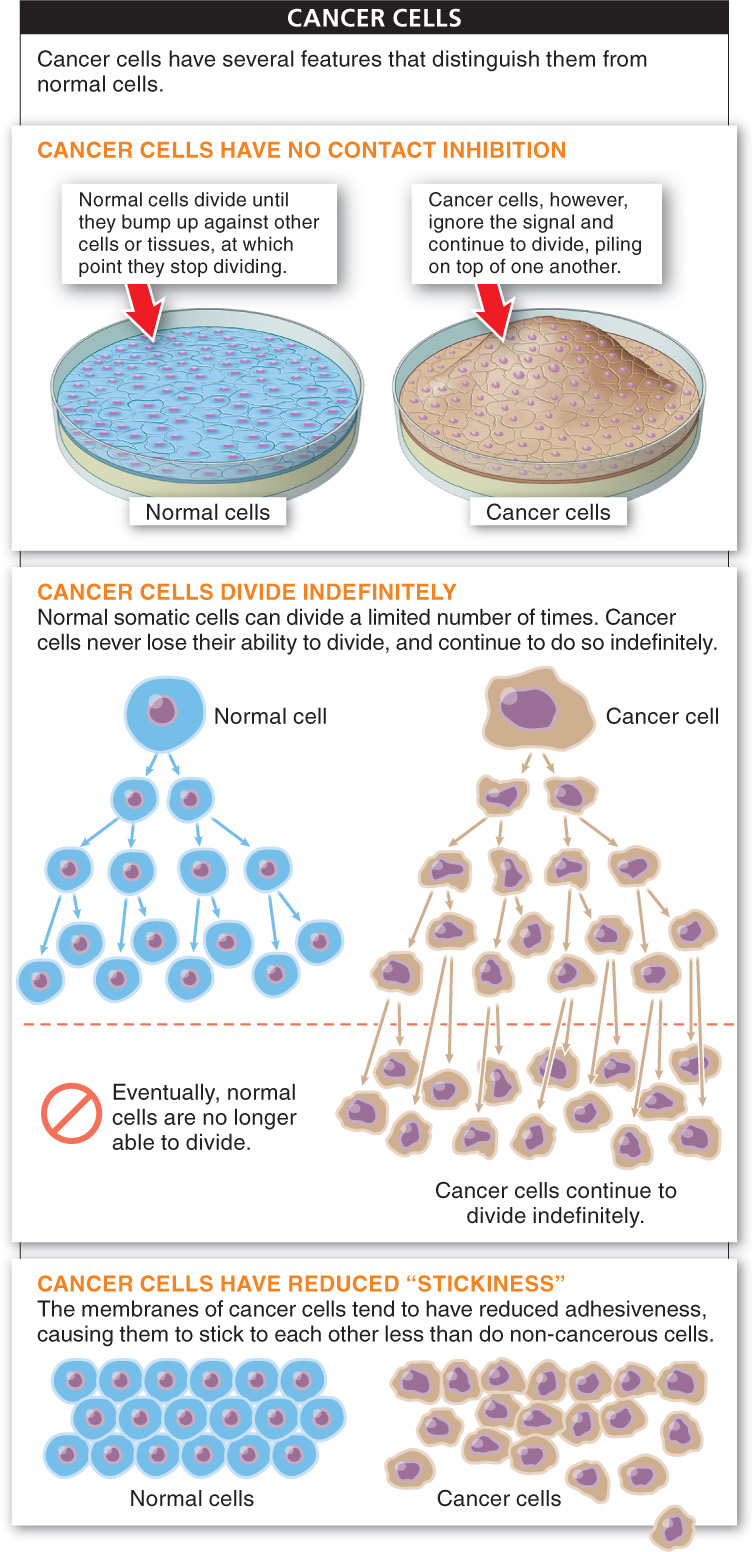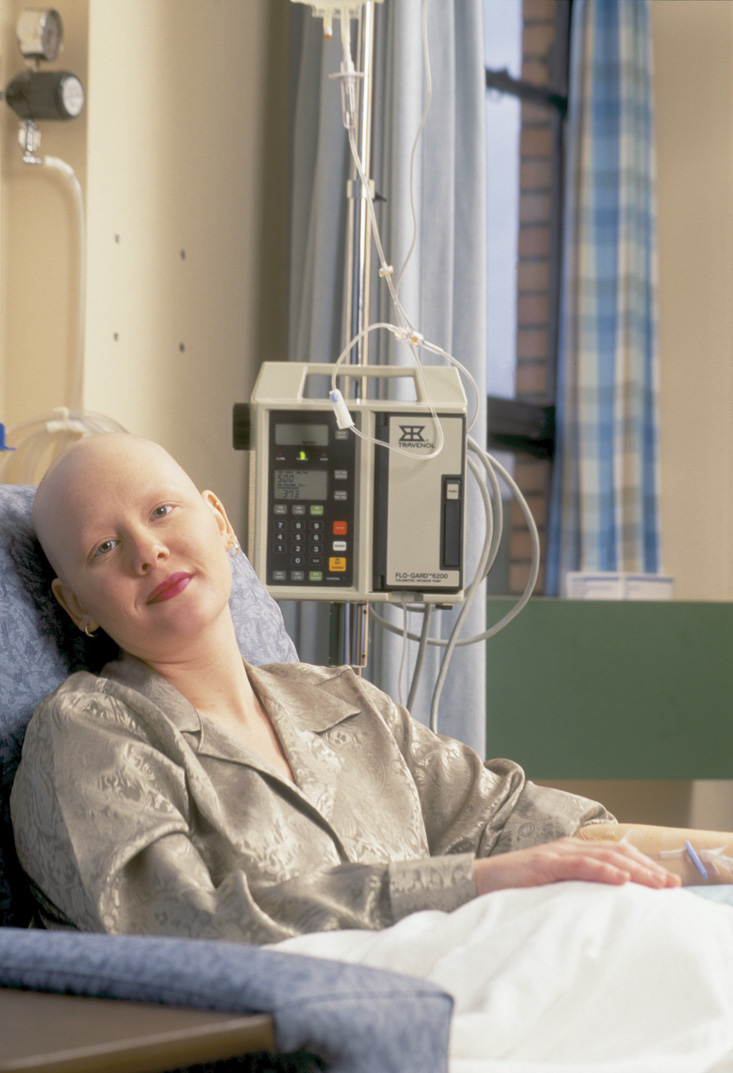Too much of a good thing can be bad. This is especially true when cell division runs amok, a situation that can lead to cancer. Cancer is defined as unrestrained cell growth and division that can damage adjacent tissues. Some cancers can metastasize, or spread to other locations in the body. Cancer can cause serious health problems and is the second leading cause of death in the United States, responsible for more than 20% of all deaths. Only heart disease causes more deaths.
17
Cancer occurs when some disruption of the DNA in a normal cell interferes with the cell’s ability to regulate cell division. DNA disruption can be caused by chemicals that mutate DNA or by sources of high energy such as X rays, the sun, or nuclear radiation. Cancer can even be caused by some viruses. However it begins, once a cell loses control over its cell cycle, cell division can proceed unrestrained (FIGURE 6-16).

“Cancer cells are those which have forgotten how to die.”
— HAROLD PINTER, playwright, from the poem “Cancer Cells,” 2002
Cancer cells have several features that distinguish them from normal cells; the three most significant differences are the following:
1. Cancer cells lose their “contact inhibition.” Most normal cells divide until they come into contact with other cells or collections of cells (tissues). At that point, they stop dividing. Cancer cells, however, ignore the signal that they are at high density and continue to divide.
2. Cancer cells can divide indefinitely. As we saw in Section 6-
3. Cancer cells have reduced “stickiness.” Cells are normally held together by adhesion molecules, proteins within cell membranes. And cancer cells, too, usually group together, forming a tumor. But the membranes of cancer cells tend to have reduced adhesiveness, causing them to stick to each other less than do non-
Tumors caused by excessive cell growth and division are of two very different types: benign and malignant. Benign tumors, such as many moles, are just masses of normal cells that do not spread. They can usually be removed safely without any lasting consequences. Malignant tumors, on the other hand, are the result of unrestrained growth of cancerous cells. They grow continuously and shed cells (FIGURE 6-17). The shedding of cancer cells from malignant tumors is how cancer spreads, a process called metastasis (meh-

18
What is cancer? How does it usually cause death?
How does cancer actually kill the organism? Somewhat surprisingly, it’s not because of some chemical or genetic property of the cancer cells themselves. It’s simpler than that. As a tumor gets larger, it takes up more and more space and presses against neighboring cells and tissues (FIGURE 6-18). Eventually, the tumor may block other cells and tissues from carrying out their normal functions and even kill them. This cell dysfunction or cell death can have disastrous consequences when the affected normal tissue controls processes critical to life, such as breathing, heart function, or the detoxification processes in the liver.

To treat cancer, the rapidly dividing cells must be removed surgically or killed, or their division at least slowed down. Currently, the killing and slowing down are done in two ways: by chemotherapy and by radiation.
In chemotherapy, drugs that interfere with cell division are administered, slowing down the growth of tumors. Because these drugs interfere with rapidly dividing cells throughout the body (not just the rapidly dividing cancer cells), they can have very unpleasant side effects. In particular, chemotherapy drugs disrupt normal systems that rely on the rapid and constant production of new cells. For instance, chemotherapy often causes extreme fatigue and shortness of breath because it reduces the rate at which red blood cells are produced, thus limiting the amount of oxygen that can be transported throughout the body. By interfering with the division of bone marrow stem cells, chemotherapy also reduces the production of platelets and white blood cells and thus increases bruising and bleeding, as well as increasing susceptibility to infection. Another location of rapidly dividing cells commonly affected by chemotherapy and radiation is the hair follicle. As a consequence, many people lose their hair when undergoing chemotherapy. It usually grows back, however, when treatments stop.
19
Like chemotherapy, radiation works by disrupting cell division. Unlike the drugs used in chemotherapy, however, which circulate throughout the entire body, radiation therapy directs high-

What causes cancer? Researchers have made significant progress toward answering this question at the cellular level. Most cancer is caused by mutations in a cell’s DNA that disrupt the normal processes that control and regulate the cell cycle. More specifically, the cancer-
Is there hope for a complete cure soon? Not yet. Nonetheless, many potentially successful therapies for cancer treatment and prevention are on the horizon. Extensive research is being conducted on the mechanisms by which genes controlling the cell cycle are damaged in cancer cells, for example, and how such damage might be prevented or reversed.
TAKE-HOME MESSAGE 6.8
Cancer is unrestrained cell growth and cell division, which lead to large masses of cells that may cause serious health problems. It often results from mutations to genes important in controlling the cell cycle, thus reducing the effectiveness of the checkpoints. Treatment focuses on killing or slowing down the fast-
What are the three most significant ways in which cancer cells differ from normal cells?
Normal cells divide only a finite number of times, but cancer cells can divide indefinitely. Cancer cells also lose their "contact inhibition," which would normally suppress growth once cells bump up against other cells. The membranes of cancer cells have reduced adhesiveness, causing them to stick to one another less than non-cancerous cells.
20